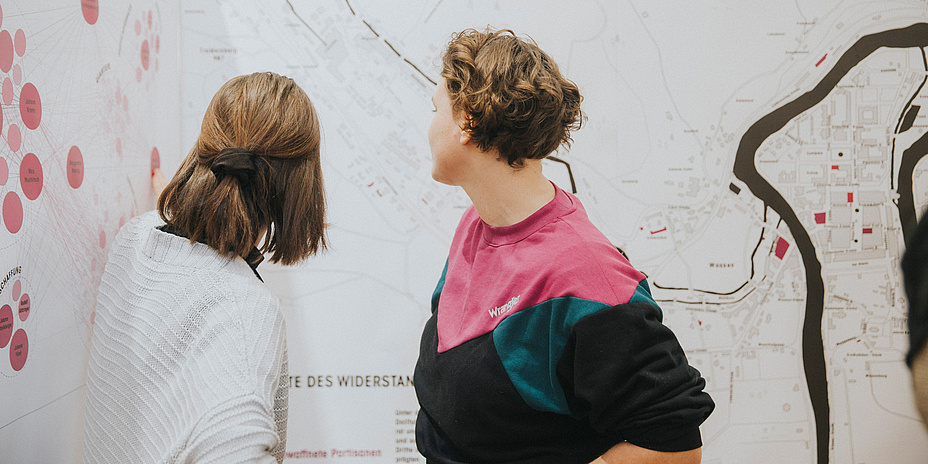Resistance against National Socialism: exhibition by architecture students

What was the resistance against National Socialism like in Styria? What was it like in Graz, Leoben, Deutschlandsberg and Eisenerz? How can budding architects carry out research and present results? At TU Graz’s Institute of Architectural Theory, History of Art and Cultural Studies, a group of architecture students has intensively dealt with these questions. On the occasion of the 75th anniversary of the liberation of Austria, they are presenting the results of their research and analysis in an exhibition curated and designed by them in Graz, Deutschlandsberg, Leoben and Eisenerz.
"Topography of the Resistance in Styria. 1938–1945"
Leoben: June 23 to July 5, Main Square (at the "Durchbruch")
Graz: July 7 to 19, Universalmuseum Joanneum, Sackstraße 16 (at the passageway)
Eisenerz: August 18 to 30, Theodor-Körner-Platz
Four locations as examples
The students spent a semester researching and documenting various aspects of acts of resistance against the Nazi regime on the basis of four locations. For this purpose, sources from archives in Austria, France, Germany and Slovenia were examined, historical documents were evaluated, biographies of participants were researched, locations of the events were reconstructed using forensic architecture, and the research results were visualized by means of information graphics, 3D visualizations and models.
The exhibition is composed of display objects that – when unfolded spatially – create an exterior and an interior space. The interior shows content about the respective local resistance varying between each exhibition location; the exterior provides a general insight into the theme of resistance in Styria between 1938 and 1945. This general documentation was prepared by students Ema Drnda, Thomas Lienhart and Lung Peng.
NS crimes in the SS barracks Graz-Wetzelsdorf 1945
In the last weeks of the Second World War in 1945, more than 200 people fell victim to Nazi crimes in the SS barracks in Graz-Wetzelsdorf. The traces of the crimes were covered up. By reconstructing what happened and carrying out research into the victims, students Lisa-Marie Dorfleitner, Max Frühwirt and Milan Sušić attempt to contribute to a reassessment of this Nazi crime.
„Kampfgruppe Steiermark“ (Task Force Styria)
Anna Sachsenhofer, Alice Steiner and Thomas Tunariu devoted themselves to the activities of the resistance group "Kampfgruppe Steiermark", which operated in the Slovenian-Styrian border area around Deutschlandsberg in 1944/45. The three students were able to trace how the members of "Kampfgruppe Steiermark" carried out resistance together with local partisans and performed acts of sabotage and disruptive actions against the NS regime. The students show that the resistance for many members of "Kampfgruppe Steiermark" had already begun with the February Uprising of 1934 against fascism in Austria and resulted in over ten years of emigration across Europe.
„Austrian Freedom Front"
The so-called "Anschluss" of Austria to the Third Reich in 1938 was also largely supported by the population in the industrial towns along the Eisenstrasse in Styria. At the same time, however, a variety of forms of resistance developed, such as the partisan group "Austrian Freedom Front" (ÖFF) in Leoben-Donawitz. The latter was only able to conduct its fight against the Nazi regime with the support of a broad network of help spread throughout Upper Styria. Even in the middle of Leoben, many people risked their lives to provide the partisans with food, clothing, information and shelter. Students Flora Flucher, Matthias Hölbling and Katharina Url use a map of the city to locate this very network and thus show the dangerous environment in which the supporters themselves operated.
Satellite concentration camp Eisenerz
On June 15, 1943, the documented history of the Eisenerz concentration camp in Gsollgraben, a subcamp of the Mauthausen concentration camp, begins with the transport of 400 Polish concentration camp prisoners from Gusen to Eisenerz. At least 126 prisoners died there by the spring of 1945. The guards of the Eisenerz subcamp never had to answer for their crimes in a court of law; at the scene in Gsollgraben today nothing reminds visitors of the satellite concentration camp. In the exhibition, students Janika Döhr, Viktoriya Yeretska and Armin Zepic localize and reconstruct the Eisenerz subcamp for the first time with the help of statements and sketches by former prisoner and survivor Jan Otrebski and additional original documents.
Kontakt
Daniel GETHMANN
Assoc.Prof. Mag.art. Dr.phil.
TU Graz | Institute of Architectural Theory, History of Art and Cultural Studies
Phone: +43 316 873 6279
Email: daniel.gethmann@tugraz.at



